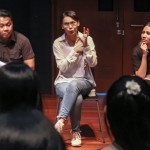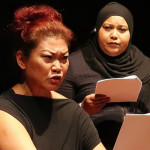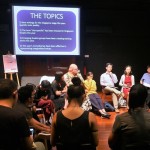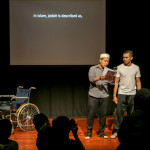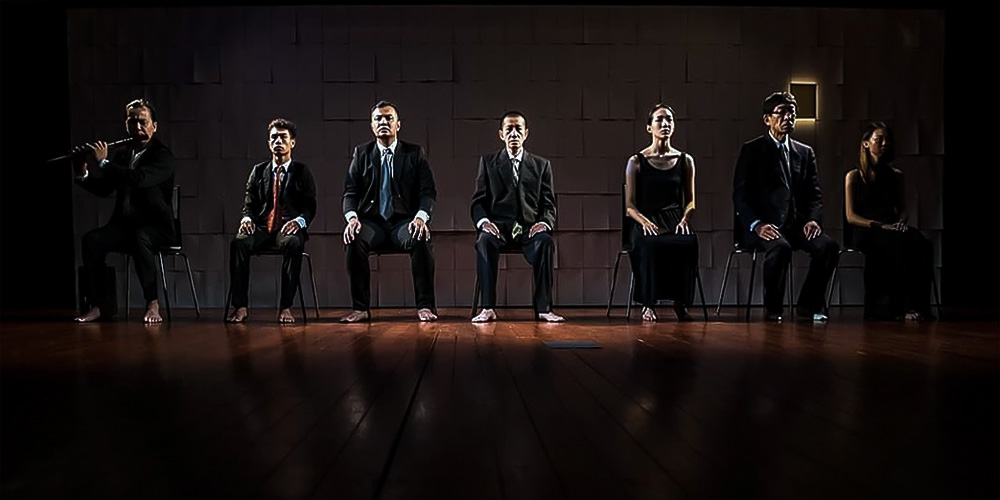
A scene from Journey to Nowhere, the festival performance from Southernmost 2018. Photo: Tuckys Photography
Southernmost – it’s the title of Emergency Stairs’ annual festival for artistic experimentation and dialogue, and also a geographic direction. At first encounter with the word, and thinking of geography as cultural politics, I think of relationships, positionality and cultures. It’s also a reference to the festival’s geographical location in Singapore, but more on that later. Into its third year in 2019, Southernmost is Emergency Stairs’ response to the question: “How do you create an arts festival for the future?” To tackle this question, I first dug briefly into arts festivals of the past and present.
As most commonly understood today, an arts festival takes place over a fixed time period, usually within a city but commonly across several venues. It usually encompasses events and performances, which can be of the same genre or of multiple art forms. The latter is sometimes referred to as the ‘combined arts festival’ in a UK context.
In this form, as researchers such as Finkel (2009) and Quinn (2010) have documented, arts festivals were mostly a post-World War II phenomenon, and the international proliferation of arts festivals occurred from the 1980s onwards. Since then, arts festivals have been examined in line with the politics of culture and place. For example, Waterman (1998) observes that arts festivals are common sites of cultural exchange and contestation, and that “promoting arts festivals is related to place promotion” (p. 54). Quinn (2010) specifically notes that “arts festivals are now a mainstay of urban tourism and urban policy-making” (p. 266).
Indeed, many cities around the world have become synonymous with their associated festivals – in film (e.g., Cannes Film Festival, Busan International Film Festival), visual arts (e.g., Venice Biennale), as well as the performing arts (e.g., Salzburg Festival, Edinburgh Festival Fringe). Waterman (1998) argues that “place-marketing strategies encourage a ‘safe’ art that attracts commercial sponsors and large audiences” (p. 64), although he also acknowledges that this is contestable.
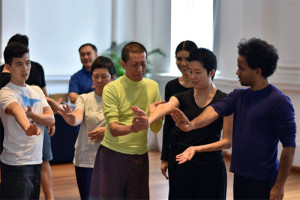
A Masterclass at Southernmost 2017. Photo: Emergency Stairs
It is noteworthy that all the above research is typically located in the European and North American context. So what of our “arts festival for the future”? Southernmost indeed places itself in opposition to many of the ideas above. Southernmost is just three years old and organised independently by a small company, in stark contrast to major arts festivals backed by extensive organisational structures. Rejecting commercialism and ‘safe’ art, the curation of each Southernmost festival has been informed by a “process-driven, artist-centric and Asia-based” philosophy (About, 2019), contributing to our ongoing decolonialisation of art and culture in the region.
The “process-driven” orientation of the festival manifests in its programming. Rather than a series of pre-packaged and immaculately-staged works, the festival encompasses workshops and showcases, open rehearsals, an Open Forum, and one performance piece devised over the duration of the festival by the participating artists. At the 2018 Open Forum, “process-driven-ness” was enthusiastically unpacked by the invited speakers, who reflected on how the artistic process can be made more visible to the public.
Along the same lines, the term “spectator-collaborator” also emerged at the 2018 Open Forum, as a proposal for an alternative to the conventional idea of the “audience.” The question of how to encourage more people to become spectator-collaborators was discussed, but compelling long-term strategies will take time to crystallise.
On the side of the artists, however, an interesting part of the 2018 edition of Southernmost was the introduction of a critic-in-residence, arts writer Corrie Tan, who documented through performative writing the full eight days of the festival process. Her blog, publicly accessible online, serves as a window into the rehearsal room for anyone who cares to peek in, and begins to build a path towards democratising and demystifying the process of art-making for the general public.
Another aspect that characterises Southernmost is its engagement with issues of the traditional and the contemporary. The participating artists of each year’s festival are mostly practitioners in various Asian art forms. Inevitably, in such a context, the idea of the “intercultural” shows up, regardless of whether it has been specifically invited to the party. The 2017 edition of Southernmost was explicitly described as an “intercultural theatre festival” by Emergency Stairs itself. Responding to the 2018 festival production, Journey to Nowhere, Cervera (2018) reflects on the festival’s interrogation of “new interculturalisms in Singapore and potentially in Southeast Asia”.
While Southernmost’s aspirations are regional, the festival’s programming is still firmly grounded in its Singaporean context. For example, Journey to Nowhere was a response to the then-newly unveiled Our SG Arts Plan 2018-2022. This year’s festival production, Journey to a Dream, hints at addressing issues related to colonialism and progress – pertinent in the year of Singapore’s Bicentennial.
Further emphasising the festival’s groundedness in the local, the name “Southernmost” makes reference to Singapore’s location as the southernmost stop in the One Table Two Chairs circuit. The One Table Two Chairs Project was pioneered in the 1990s by Danny Yung, Co-Artistic Director of Hong Kong-based company Zuni Icosahedron. The name of the project is a reference to the one-table-two-chairs set typical of traditional Chinese opera performance, and before 2000, the project invited artists to collaborate in the creation of works of 20-minute duration and only involving two artists, one table and two chairs (Yung, 2017).
The One Table Two Chairs concept has since evolved, and Southernmost adopts the movement in a wider (but somewhat less clear) framing of the festival. In the spirit of cultural collaboration and exchange, participating artists of the Southernmost festival in all three years have taken part in a series of platforms across Asia and internationally, in the months leading up to the Southernmost festival in Singapore. While this is an interesting aspect of Southernmost, unfortunately documentation of the participating artists’ processes and involvement at the other platforms has been less prominent within the overall Southernmost documentation thus far. In line with the festival’s focus on being process-driven and expanding the concept and role of the audience, it would seem valuable for the public to also gain an insight into the wider One Table Two Chairs process and its relationship to Southernmost.
The 2019 edition of Southernmost is right around the corner. For this year’s festival, unlike in previous years, a dedicated website has been launched, making it much easier to navigate the festival’s programmes and schedule. An active social media campaign is underway on Facebook, including an “Ask Xiaoyi Anything” series, where Artistic Director of Emergency Stairs and festival curator Liu Xiaoyi responds to questions from the public about Southernmost and/or his work. This post has sparked intense and meaningful conversations with festival audiences – an apt way to involve the audience more in understanding Liu’s thoughts and influences surrounding the creation and curation of Southernmost. The critic-in-residence will be back again – this time LASALLE graduate Ke Weiliang is taking the reins as the festival’s process scribe.
Has Emergency Stairs succeeded in creating an arts festival for the future? Just three years in, it’s hard to tell. But as I wrap up my thoughts on Southernmost, it is not lost on me that I’m writing about the decolonialising aspirations of a festival in the conventions of Western academic writing. This quandary convinces me that we in Singapore and Asia need more of the kinds of work that Emergency Stairs and Southernmost are pursuing.
By Jocelyn Chng
Published on 22 October 2019
Southernmost 2019 is jointly presented by Emergency Stairs and Zuni Icosahedron, and will be held at Centre 42 from 5 to 12 November 2019. Programme and ticketing details can be found here.
References
- About Southernmost. (2019). Retrieved from https://www.southernmost.sg/festival
- Cervera, F. (2018). “Southernmost”: The Politics of Nowhereness. Retrieved from https://artsequator.com/southernmost-2018/
- Finkel, R. (2009). A picture of the contemporary combined arts festival landscape. Cultural Trends, 18(1), 3-21. https://doi.org/10.1080/09548960802651195
- Quinn, B. (2010). Arts festivals, urban tourism and cultural policy. Journal of Policy Research in Tourism, Leisure & Events, 2(3), 264-279. https://doi.org/10.1080/19407963.2010.512207
- Waterman, S. (1998). Carnivals for élites? The cultural politics of arts festivals. Progress in Human Geography, 22(1), 54-74. doi: 10.1191/030913298672233886
- Yung, D. (2017). One Table Two Chairs – Interview with Danny Yung (Part 1). Retrieved from https://artsrepublic.sg/backstage/one-table-two-chairs-interview-with-danny-yung-part-1/

